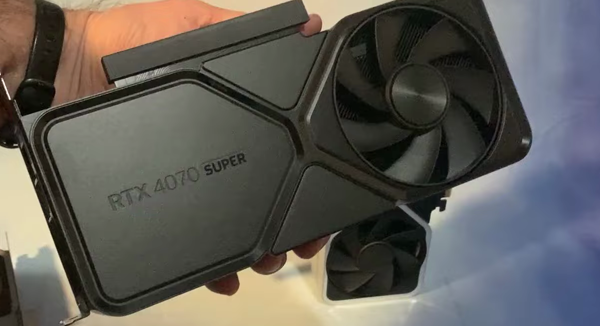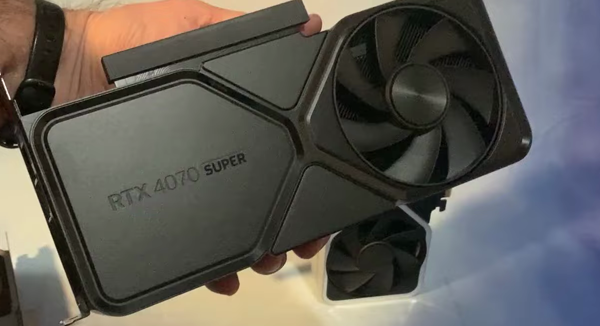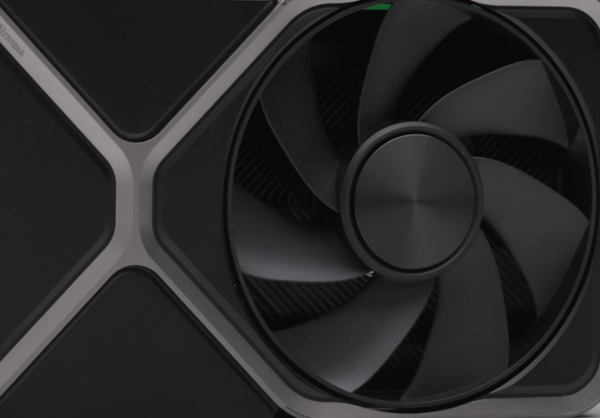Note: As an Amazon Associate we earn from qualifying purchases.
My thoughts on the NVIDIA GeForce RTX 4070 FE Graphics Card (in titanium black) (2024)
Introduction
For work I recently upgraded my graphics card to the NVIDIA GeForce RTX 4070 FE. This new model has significantly improved my computing experience compared to my previous EVGA 1080. In this review, I will discuss the features, cooling efficiency, and value for money of the RTX 4070 in today’s GPU market.
Specifications
| Property | Value | Property | Value |
|---|---|---|---|
| Graphics Coprocessor | NVIDIA GeForce RTX 4070 | Brand | NVIDIA |
| Graphics Ram Size | 12 GB | GPU Clock Speed | 2248 GHz |
| Video Output Interface | DisplayPort, HDMI |
Photos
Click on photos to enlarge them:
Prices
Check prices of the NVIDIA RTX 4070 FE Titanium Black on:
Introducing NVIDIA RTX 4070

The NVIDIA GeForce RTX 4070 is a leap forward for my gaming and content creation setup, packed with the latest Ada Lovelace architecture that promises blazing-fast ray tracing and AI-enhanced capabilities. Here’s an early rundown of its core features:
Graphics Processing Unit: NVIDIA GeForce RTX 4070, a notable successor to the previous generations.
GPU/Clock Speed: A stable 2.48 GHz boost clock, perfect for demanding applications.
On-Board Memory: A hefty 12GB GDDR6X, which is just the right sweet spot for modern gaming needs.
Technologies: Boasts 5,888 CUDA Cores and advanced features like DLSS 3.
Outputs: Flexible HDMI and DisplayPort options, ensuring compatibility with a variety of displays.
I upgraded from an EVGA 1080, which lasted over five years as a powerhouse. The reason for the switch was simple: I needed something more current, and the RTX 4070 seemed to offer that without being excessively flashy. The lack of LED lights was a plus for me; I prefer a more understated look.
On first impressions, the RTX 4070 runs quieter than I expected, which is great for long gaming sessions. I’ve noticed a significant improvement in fps compared to my old 1080. Moreover, the card’s size is more compact, yet it doesn’t compromise on performance. This shows that you don’t always need the biggest, most expensive option to get excellent results.
An interesting aspect I’ve found is the thermal performance. Even in a warm room, the first fan keeps the temperature around 35°C, which is impressively low. Under stress, it barely climbs past 42°C. For those curious about overclocking, there’s plenty of headroom to push the card further without worrying about overheating.
However, there’s a slight concern that I noticed only after the purchase—the RTX 4070 is somewhat overpriced compared to the 4070 Ti, even if the performance doesn’t quite match up. It’s an unfortunate oversight on my part; a bit more research could have saved me some money, and naturally, it’s an important consideration for anyone eyeing the RTX 4070.
In summary, the NVIDIA RTX 4070 offers a solid upgrade for those looking to significantly boost their gaming and creative work without going overboard financially. The thermal efficiency and quieter operation are big pluses, though the pricing strategy NVIDIA has taken may be a bit perplexing considering the close competition with the 4070 Ti. If you’re on the fence, I’d recommend weighing the pros and cons carefully before making the leap.
Performance and Cooling Efficiency

The NVIDIA GeForce RTX 4070 FE has noticeably elevated my gaming and content creation workflow to new levels, thanks to its potent combination of performance features and cooling efficiency. Based on the NVIDIA Ada Lovelace architecture, the GPU’s capabilities are impressive, with a boost clock speed that peaks at a whopping 2.48 GHz.
Here are some of the key strengths and a slight drawback that I’ve come across:
High Clock Speed: A boost clock speed of 2.48 GHz enhances performance in demanding tasks.
AI-Accelerated Performance: Integrates DLSS 3, making games look stunning while running smoothly.
Ample Memory: 12GB GDDR6X memory is more than adequate for both current and upcoming games and creative software requirements.
Efficient Cooling: Even under stress tests, the card remains cool with temperatures just hitting 42°C at the highest.
Quieter Operation: Often only one fan is active during less demanding tasks, maintaining a quiet PC environment.
The card’s dedicated Ray Tracing and Tensor Cores allow for both fast ray tracing and AI-accelerated applications, which really brings modern games to life with realistic lighting and reflections. However, one slight drawback is the lack of LEDs, which might be a downside for those who prefer a more visually customizable rig.
In terms of performance, one thing that stands out to me is that even though this GPU is smaller in size compared to my previous card, it nonetheless has a significant impact on frame rates. Switching from an EVGA 1080 FTW2, I’ve seen a vast improvement – it’s quite astonishing. The RTX 4070 FE operates quietly, and most of the time, it doesn’t even need to run its fans at full blast, showcasing the efficiency of its cooling system.
Moreover, the GPU keeps things cool enough that I see a lot of room for overclocking without worrying about overheating. This factor is crucial for longevity and sustaining performance over time. Its Impressive Thermal Management ensures that even when pushed, the system remains stable and performs exceptionally.
On a more critical note, when considering the price point relative to the more powerful 4070-ti, it may seem less attractive to some buyers. Indeed, factoring in the performance difference and the higher cost of the RTX 4070 FE, I can understand why some may feel a pang of buyer’s remorse. Yet, from my perspective, the performance-to-price ratio fits my budget and meets my needs without pushing into financial discomfort.
While I am not thrilled about its relative cost when compared to the 4070-ti, I believe the RTX 4070 FE stands firmly on its merits for users like myself, who are looking for a substantial upgrade that doesn’t require venturing into four-figure territory.
Connectivity and Compatibility

When considering the NVIDIA GeForce RTX 4070 FE, connectivity and compatibility are essential features for any avid gamer or content creator like me, especially if you’re planning to integrate this GPU into an existing system or build a new one.
Here’s a quick rundown in terms of these aspects:
Compatibility with PCIe Interfaces: This card comes with support for both PCI Express 4.0 and backward compatibility with PCI Express 3.0, which is great since you don’t need the latest motherboard to get this card up and running. It fitted seamlessly into my setup without a hitch.
Onboard Memory: With 12GB of GDDR6X memory, I’ve got more than enough bandwidth to handle the latest games and heavy-duty content creation tasks without any lags or stutters.
Output Options: The card provides HDMI and DisplayPort outputs, giving me the flexibility I need for various display setups. Dual monitor setup was a breeze to configure, and the video quality is top-notch.
GPU/Clock Speed: Its boost clock speed of 2.48 GHz gives me the confidence that the GPU won’t bottleneck even the most demanding scenarios.
One thing I noticed right away is the simplicity of the design. NVIDIA went for a clean, no-frills look here, which I prefer. The lack of LED lighting is actually a plus in my book—I’m more about performance than flashiness. The card isn’t just pleasing aesthetically; it’s also a quiet worker. The fans almost whisper even under load, and the temperatures are impressively low, which tells me the card is efficient in its heat management.
However, on the downside, it’s not lost on me that there is a notable price difference when compared to the 4070-ti variant, which seems to offer better performance metrics. It does make you wonder if the jump in price equates to a proportional jump in value. As someone who watches their budget, this is a consideration that can’t be taken lightly, and it’s something potential buyers should weigh.
Despite that, for my use case, the NVIDIA GeForce RTX 4070 FE hits the sweet spot between price and performance. It’s a powerful upgrade from my previous card, and for the current price, I feel it was a smart investment without going overboard. It has everything I need for intense gaming sessions and content creation. Should I require more power in the future, it’s good to know there’s room to overclock, but, as of now, it’s more than sufficient.
Of course, for anyone considering this card, I’d suggest a bit of research to see how it fits into your current or intended rig to ensure no surprises with the price-to-performance ratio. But for those looking for a reliable upgrade that won’t demand a second mortgage, the RTX 4070 FE is a strong contender in its field.
Value Versus Cost Evaluation

In my assessment of the NVIDIA GeForce RTX 4070 FE, I’ve wrestled with the balance between value and cost. The GPU market is a minefield of options and finding the sweet spot for both performance and budget is key.
Pros
The RTX 4070 FE is built with the NVIDIA Ada Lovelace architecture, offering up a big leap in efficiency and speed.
A substantial 12GB of GDDR6X memory is more than adequate for today’s heavy gaming and content creation demands.
The boost clock speed of 2.48 GHz signifies robust performance potential.
Helpful technologies like DLSS 3 and ray tracing significantly improve gaming visuals and performance.
At $599.00, it’s positioned as a mid-range card offering good performance for the price.
Cons
The price compared to performance does raise eyebrows when the RTX 4070 Ti exists at a somewhat higher price point but with marked improvements.
The lack of EVGA as a manufacturer might deter brand loyalists after their exit from the market.
Upgrading from an EVGA 1080 FTW2, I was immediately struck by the 4070’s silent operation and its impressive ability to stay cool, with temperatures rarely pushing past 42°C even under stress—this is a notable improvement. Gone are the days of flashy LED lights; this card is all about efficiency and quiet power. For someone who values a cool and silent rig, this factor alone might justify the upgrade.
The compact size of the card was another pleasant surprise, especially given its relatively powerful output. It’s a reminder that the latest tech can come in smaller packages without compromising on firepower.
Now, the issue of cost—yes, it’s over £150 more expensive than a 4070 Ti. At first glance, it seems like a tough pill to swallow. However, considering the entire landscape, I find the price quite reasonable for the performance offered. In the realm of GPUs, especially post-pandemic, finding a card that doesn’t require a small loan is refreshing.
To sum it up, the NVIDIA GeForce RTX 4070 FE strikes a chord with those on the prow for a balance between cutting-edge tech and budget mindfulness. By no means a budget card, it still manages to sit in the mid-range category offering great features and power that many users will appreciate. It’s not perfect, but the RTX 4070 FE definitely has an audience who will value its strengths over its few weaknesses.



